The Oracle Integration prebuilt library provides diverse “recipes” to get you started on your integration journey. For example, there are 24 prebuilts just for connecting Oracle ERP Cloud with diverse applications such as Oracle CX Sales, Shopify, Salesforce, Oracle E-Business Suite, SAP Ariba, and Adobe Sign. The prebuilt library is constantly growing at a rapid pace to help you save time and cost to get started with your automation and integration endeavors.
This blog reviews the prebuilts for the Food and Beverage industry, specifically between Oracle MICROS and Oracle Fusion Cloud applications. The Oracle Food and Beverage Global Business Unit delivers fully integrated solutions, customized to fit unique business requirements. With a robust end-to-end portfolio, Oracle MICROS enables food and beverage operations to streamline daily tasks and increase speed of service, while elevating the guest experience.
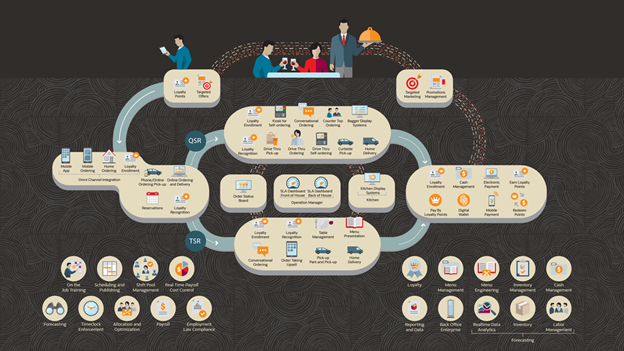
The Oracle Integration prebuilt library includes Oracle MICROS Simphony with Oracle Fusion Cloud prebuilts, published in the Integration Store. These prebuilts help to achieve the following use cases:
- Automated employee onboarding and enablement
- Automated payroll processing
- Export of restaurant sales and operational data for analytics
- Daily restaurant sales accounting
- Inventory Management
- Purchase order processing
Let’s take a closer look at the Oracle Fusion HCM Cloud prebuilt integrations for Oracle MICROS Simphony. The following diagram shows how Oracle Integration is leveraged to create or update employee records, payroll, and labor data bidirectionally between Oracle MICROS Simphony Labor and Oracle Fusion HCM Cloud.

The employee information is read from Oracle Fusion HCM Cloud using Atom feeds, and a generic Oracle Integration SOAP adapter calls the Simphony Labor SOAP service to insert and update the employee record information.
Let’s review how to find and install a prebuilt in the Integration Store. On the Oracle Integration Home page, in the Use a recipe/accelerator section, click View All.

On the Recipes and accelerators page, find the recipe you want to install. Use the search, filter, and view tools to narrow your search, filter and sort the list, and change how the list is displayed. For this example, click the Open Input Search icon, then enter Simphony and press Enter to search for matching prebuilts.

To install the prebuilt used for this example, hover over the Oracle Fusion Cloud HCM — Oracle MISCROS Labor Management | Employee creation card and click the Install icon.

To view the details for a prebuilt, hover over the card and click the Open details icon. Under Learn more, click How to use this recipe to open the documentation for the prebuilt.

When the card shows INSTALLED, hover over the card and click the Configure icon to open the Configuration Editor for the prebuilt, as shown below.

Let’s configure the Oracle Fusion HCM Cloud connection using basic credentials. Hover over the Oracle Fusion HCM Cloud Connection MICROS connection, then click the Edit icon.

Let’s configure the Oracle MICROS SOAP LABOR connection using basic credentials. Hover over the Oracle MICROS SOAP LABOR connection, then click the Edit icon.
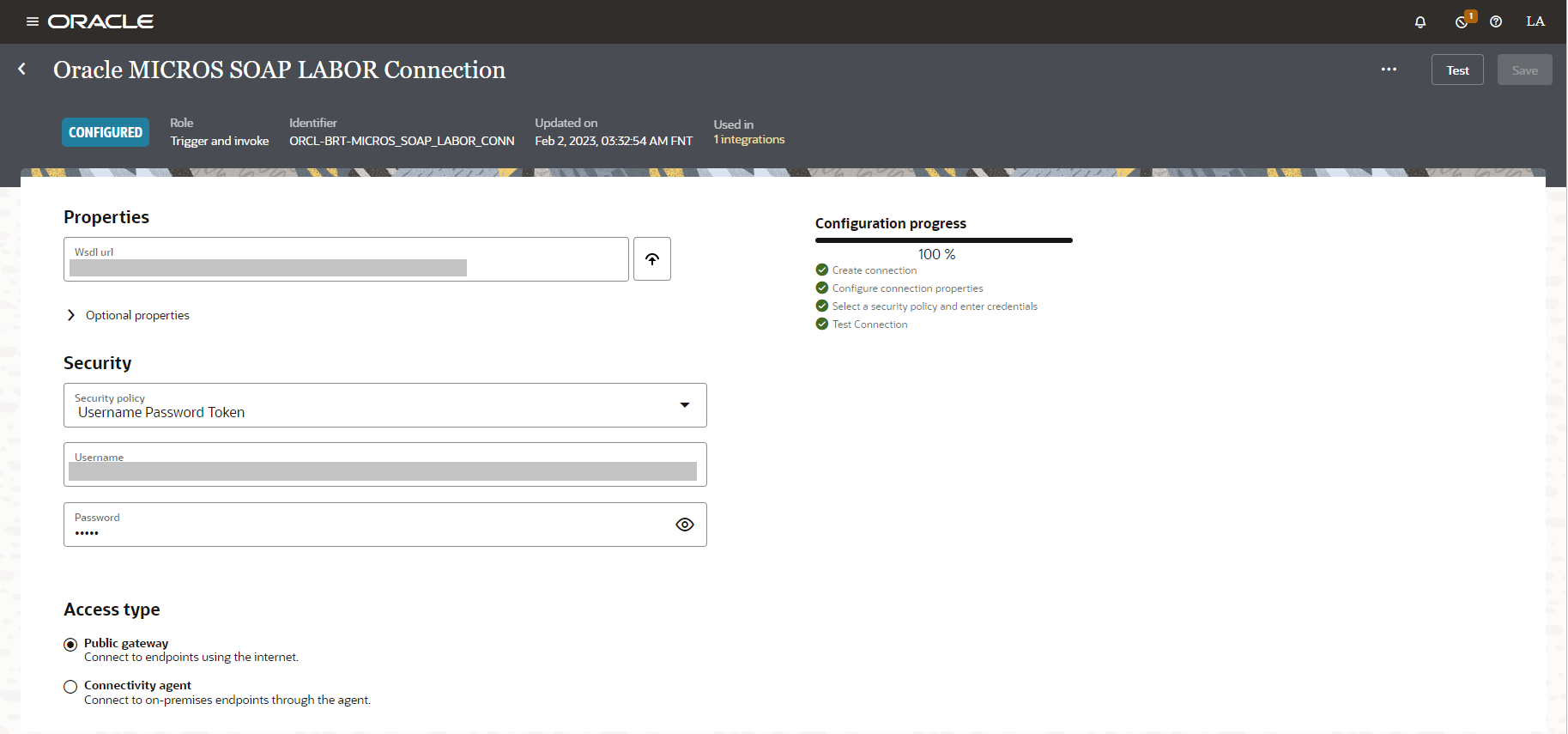
As shown above in the Properties section, enter the Oracle MICROS Labor Management SOAP service URL. In the Security section, enter the Username and Password to configure the Oracle MICROS Labor Management connection. To learn more about configuring the connections, see the documentation here .
Once the connections are configured, you can configure the lookup tables. The prebuilt includes following lookup tables:
- Oracle-BRT-HCM_MICROS_StoreMapping – This lookup holds the mapping between HCM Location Code and Simphony Labor Management Location reference.
- Oracle-BRT-HCM_MICROS_JobMapping – This lookup table stores the mapping between HCM and Simphony Labor Management job code, role mappings
- Oracle-BRT-HCM_AtomFeed_TimeStamp – This lookup holds the last successful processed entry from HCM Atom Feed.
- Oracle-BRT-HCM_Micros_Notification_Config – This lookup table contains the information needed to trigger the error handlers.

To learn more about the lookup tables, review the documentation here.
Finally, you can activate and run the prebuilt. In the Configuration Editor, click Activate in the title bar.

In the Activate Package dialog, click Activate again. A message confirms that the integrations have been submitted for activation. Once the integrations are activated, the prebuilt is ready to run.

Now let’s test the prebuilt solution. In a normal day-to-day hiring process, a recruiter uses Oracle Fusion HCM Cloud to review the job requisitions for various job postings and rolls out offers to the desired candidates. As an offer is approved, the offer is extended to the candidate.
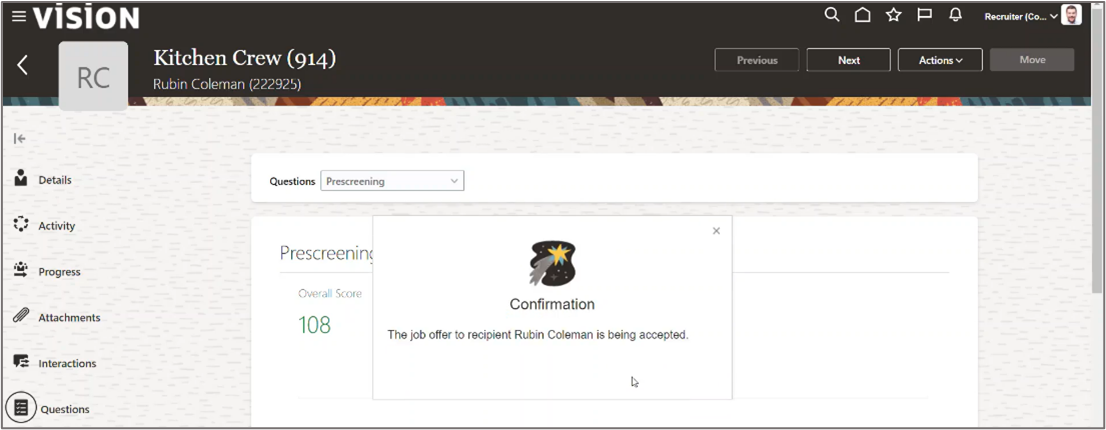
Once the candidate accepts the offer, the HR specialist fills in the necessary information and converts the candidate into an employee.
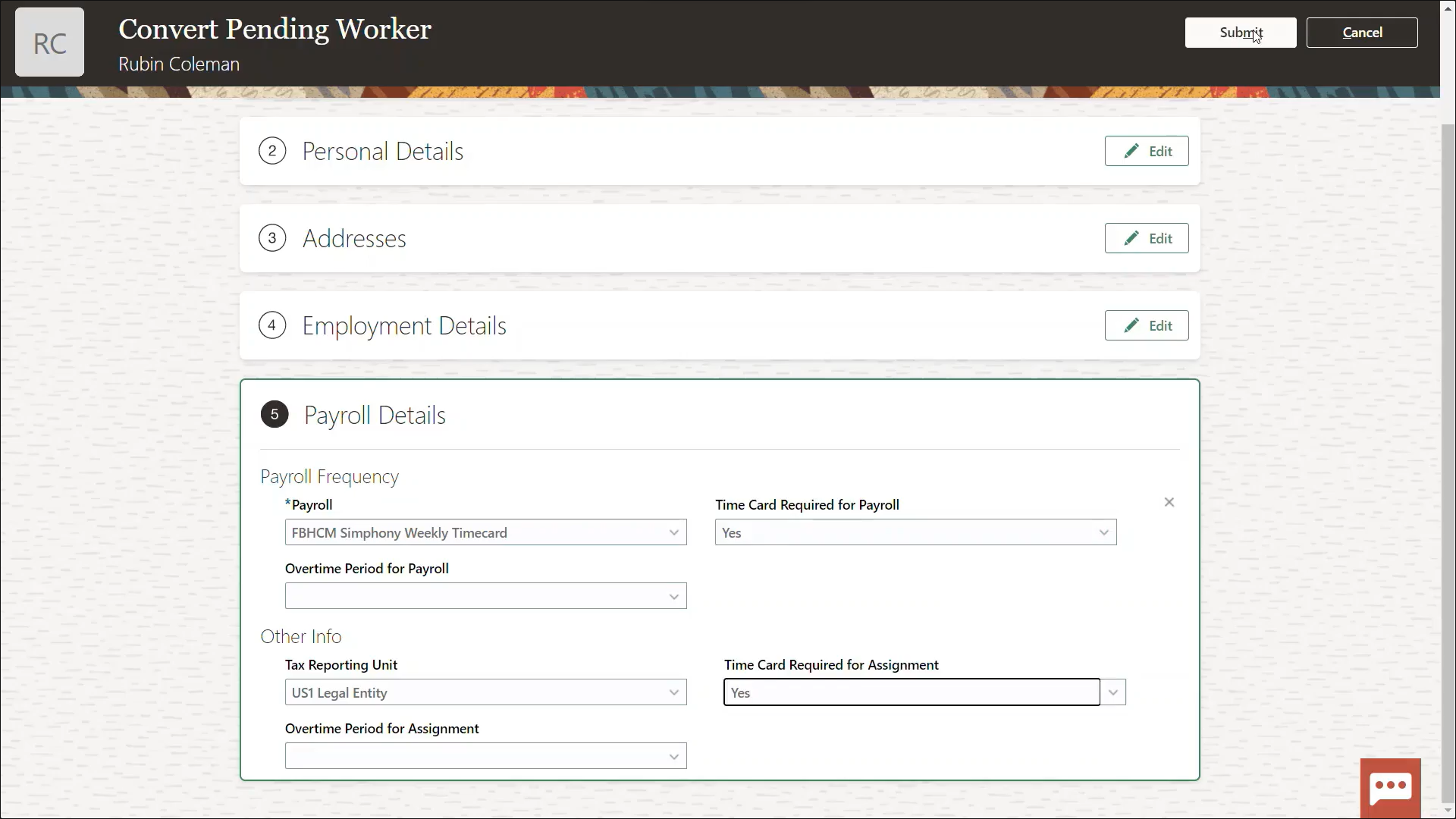
For testing the prebuilt solution, let’s submit the Oracle Fusion HCM Cloud Get Employee scheduled integration flow to fetch the newly created employee. In a production scenario, this can be scheduled to run every 30 minutes or twice a day, depending on the customer’s needs.

Oracle Integration supports monitoring the running instances using the Observability feature, as described in the documentation here.

In this example, we can see that the scheduled integration flow has run, which in turn runs a child integration flow to create an employee record in Oracle MICROS Labor Management.
Let’s now validate the newly created employee in the Oracle MICROS Labor Management application.
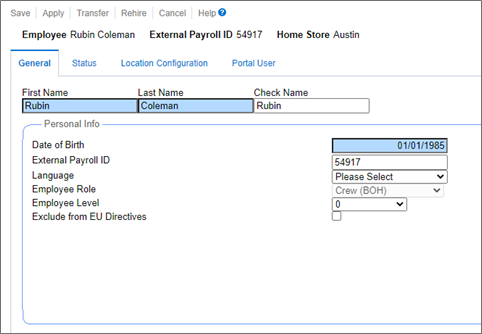
The new employee record, Rubin Coleman, is successfully created in Oracle MICROS Labor Management.
With Oracle Integration prebuilts, you can review the design and make modifications to meet your specific business needs. Let’s review how this prebuilt was developed.

In a nutshell, the Oracle Fusion HCM Cloud Get Employee integration flow fetches the recently created employees using Atom feeds, iterating over the fetched employees, and calling a second integration flow to create an employee record in Oracle MICROS Labor Management. Atom feeds enable you to keep track of any changes made to feed-enabled resources in Oracle Fusion HCM Cloud. To learn more about Atom feeds, review the documentation here.
The Oracle Fusion HCM Cloud adapter simplifies fetching the Atom feed resources in the integration flow using a simple configuration wizard. Let’s review the Atom feed configuration in the prebuilt.
Click the GetNewHires node and select the Edit submenu.
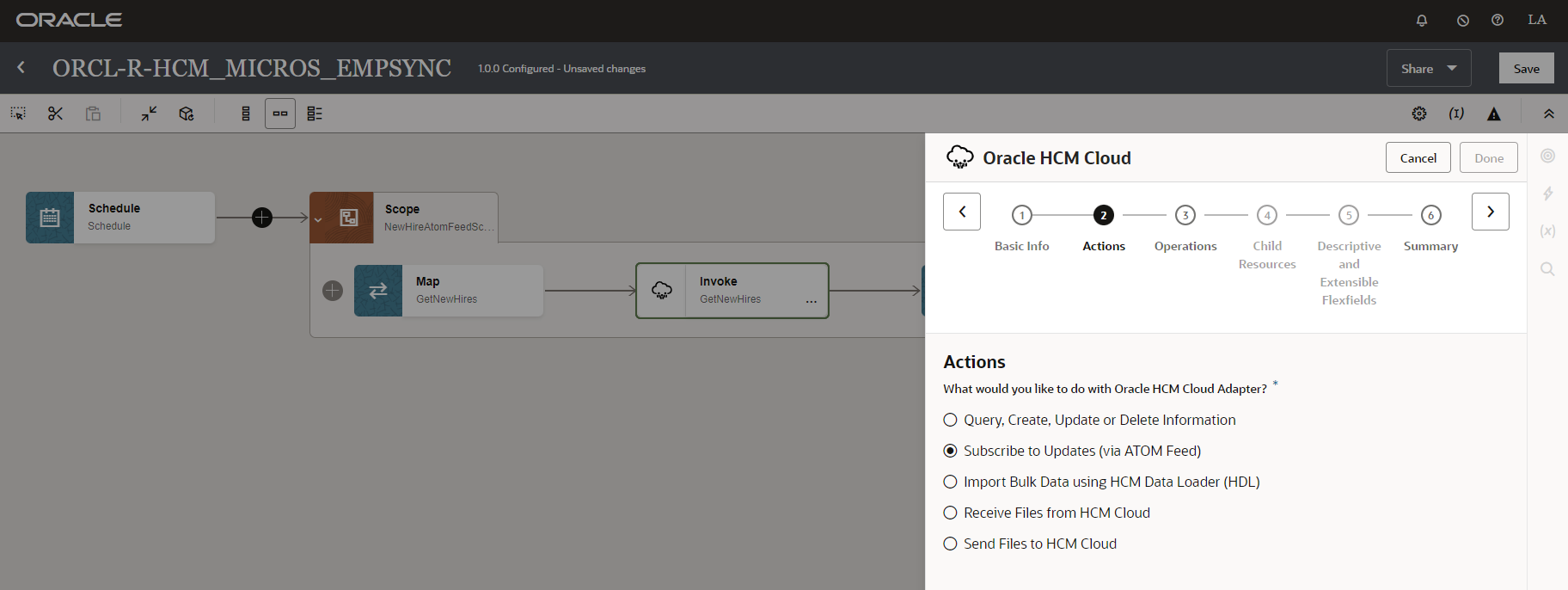
The Oracle MICROS Labor Management Create Employee integration flow is a REST trigger-based integration flow, which takes employee details in the REST payload and creates the employee record in Oracle MICROS Labor Management.
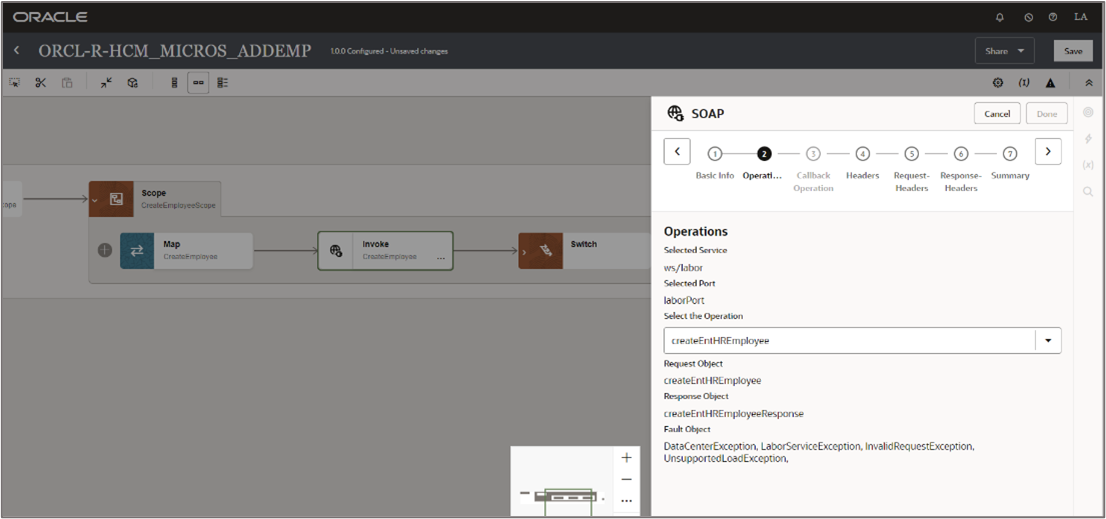
As shown above, configuration of a SOAP endpoint is simplified by the generic SOAP adapter through the wizard-based configuration. The Oracle Integration generic SOAP can be used to communicate with a diverse set of applications that support the SOAP protocol for interoperability.
This concludes this blog on using an Oracle Integration prebuilt to integrate Oracle Fusion HCM Cloud with Oracle MICROS Labor Management for employee creation. This is just one of dozens of prebuilts that are available in the Integration Store. Always look for an already available prebuilt solution before building your own solution. Oracle Integration is committed to continually publish useful prebuilt solutions to help Oracle customers reduce time to value and increase the return on investment in Oracle products and services.
